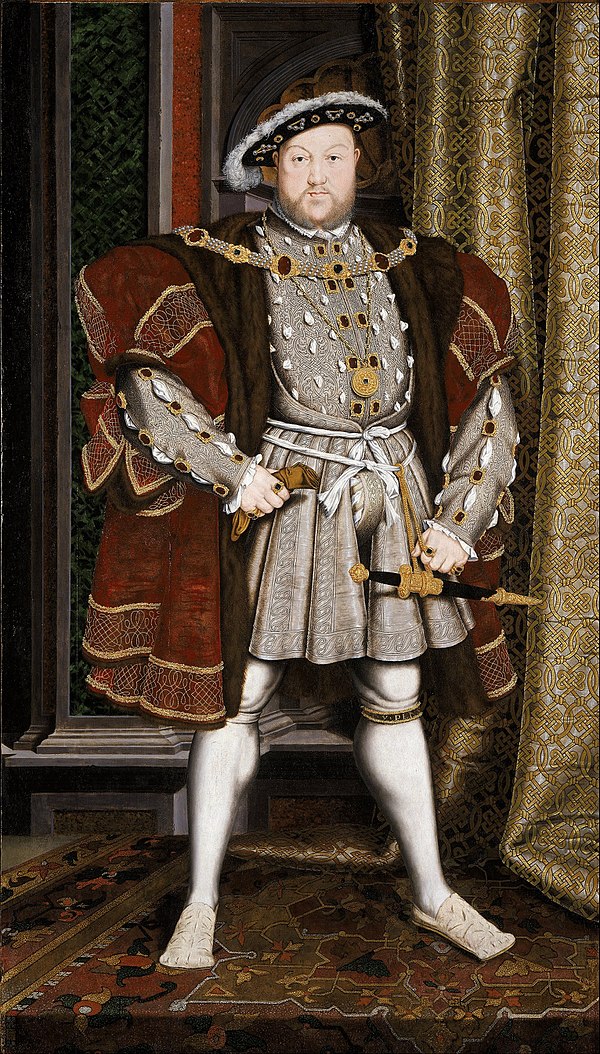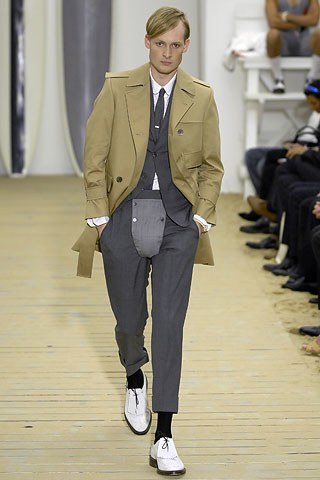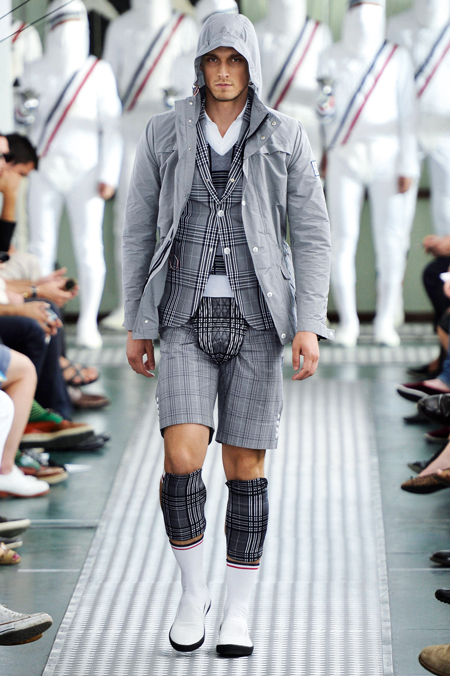Originally created as the join between the two hoses at the groin, the codpiece eventually became an ornate piece of male dress in the 16th century.
The Details
T
he codpiece as a feature of male dress dates to the 15th and 16th centuries during the Renaissance. In reference to the codpiece, Susan Brown, editor of Fashion: The Definitive History of Costume and Style writes that in 1540:
“The codpiece reaches its peak in terms of size and decoration. Designed to cover the gap between the two legs of men’s hose, it is packed and shaped to emphasize rather than disguise the genital area.” (79)
Brown later goes on to explain:
“The origins of the codpiece lie in the triangle of fabric used to join the two separate hose legs in the late 15th century when doublets shortened. Soon padding was added and ended up as the codpiece–a prominent, suggestive shape filling the gap between the legs of the breeches. It soon became a normal part of male clothing, in style across many countless and social levels until the end of the 1500s. Tailors became as creative with codpiece shapes as with other clothing details. The codpiece could hide a pocket or even be used as a pincushion.” (89)
Fig. 1 - Hans Holbein the Younger (German, 1497-1543). Portrait of Henry VIII, 1537-1547. Oil on canvas; 239 x 134.5 cm (94.09 x 52.95 in). Liverpool: Walker Art Gallery, WAG 1350. Source: Wikimedia
Fig. 2 - Agnolo Bronzino (Italian, 1503–1572). Portrait of Guidubaldo della Rovere, 1532. Oil on canvas; 114 x 86 cm (44.8 x 33.8 in). Florence: Palazzo Pitti. Source: Pinterest
Fig. 3 - Giovanni Battista Moroni (Italian, 1520-1578). Portait of Antonio Navagero, 1565. Oil on canvas; 115 x 90 cm (45.3 x 35.4 in). Milan: Pinoteca Di Brera, 334, Room 14. Source: Brera Pinacoteca
Fig. 4 - Paolo Veronese (Italian, 1528–1588). Boy With a Greyhound, ca. 1570s. Oil on canvas; 173.7 x 101.9 cm (68 3/8 x 40 1/8 in). New York: The Metropolitan Museum of Art, 29.100.105. Bequest of Mrs. H. O. Havemeyer, 1929. Source: The Met
The Berg Dictionary of Fashion History catalogs the evolution of the codpiece, writing:
“Period: 15th century.
The front flap forming a pouch at the fork of the long hose. ‘A kodpese like a pokett’ (ca. 1460, Townley Mysteries).
Period: 16th century.
When worn with trunk-hose, the codpiece was padded and very prominent and tied to the hose with points.
Period: 17th and 18th centuries.
When the projecting pouch was discarded the term was often applied to the front fastening of the breeches, and, in the 18th century, occasionally to the front fall of the breeches.”
In reference to the beginnings of the codpiece and its symbolic power, Sandra Evenson in the Encyclopedia of Clothing and Fashion writes:
“Originally a triangle of cloth used to join the individual legs of men’s hose, the codpiece emerged as a nonverbal statement of political and economic power.” (276)
While generally worn as part of everyday dress (Figs. 1, 3, 4) the codpiece was also worn as a part of an aristocratic battle dress (Fig. 2) and even incorporated into full metal suits of armor (Fig. 5).
Fig. 5 - Kunz Lochner (German, 1510–1567). Armor of Emperor Ferdinand I (1503–1564), 1549. Steel, brass, leather; h. 170.2 cm (67 in; wt. 24kg (52 lb. 14 oz.)). New York: The Metropolitan Museum of Art, 1933. 33.164a–x. Rogers Fund and George D. Pratt Gift. Source: The Met
Its Afterlife
The codpiece has been occasionally revived in modern fashion (Fig. 6), as in Thom Browne’s Spring 2008 menswear collection or Moncler Gamme Bleu’s Spring/Summer 2012 collection (Fig. 7).
Fig. 6 - Thom Browne (American, 1965-). Menswear, Spring 2008. Source: Vogue
Fig. 7 - Moncler Gamme Bleu. Menswear, Spring/Summer 2012. Source: Sotheby's
References:
- Brown, Susan, ed. Fashion: The Definitive History of Costume and Style. New York: DK Publishing, 2012. http://www.worldcat.org/oclc/840417029.
- Evenson, Sandra Lee. Encyclopedia of Clothing and Fashion. Detroit: Charles Scribner’s Sons, 2005. Gale Virtual Reference Library. http://libproxy.fitsuny.edu:2200/ps/i.do?id=GALE%7CCX3427500132&v=2.1&u=fitsuny&it=r&p=GVRL&sw=w&asid=90b0c9d2e306f42a3591c8aa24f25ecf. (accessed Feb. 13, 2016).
- “Codpiece.” The Berg Fashion Library. (n.d.). http://libproxy.fitsuny.edu:2105/view/bdfh/bdfh-div11022.xml (accessed 12 Feb. 2016).
- Evenson, Sandra. “Codpiece.” The Berg Fashion Library. 2005. http://libproxy.fitsuny.edu:2105/view/bazf/bazf00132.xml (accessed 12 Feb. 2016).
- “Codpiece.” Wikipedia, October 8, 2017. https://en.wikipedia.org/w/index.php?title=Codpiece&oldid=804403647.
- “Codpieces: Style on the Rise on Sotheby’s Blog.” Accessed October 14, 2017. /en/news-video/blogs/all-blogs/sotheby-s-magazine–december-2016/2016/11/codpieces-in-art-old-master-paintings.html.
- “Comments on the Codpiece.” The First Book of Fashion. Accessed October 14, 2017. http://thefirstbookoffashion.tumblr.com/post/67079750375/comments-on-the-codpiece.
- Mirabella, M. Bella, ed. Ornamentalism: The Art of Renaissance Accessories. Ann Arbor: University of Michigan Press, 2011. http://www.worldcat.org/oclc/949986702.
- Stall-Meadows, Celia, and Leslie Stall Widener. Why Would Anyone Wear That? Fascinating Fashion Facts. Chicago: The University Of Chicago Press, 2013. http://www.worldcat.org/oclc/900354080.
- Steele, Valerie, ed. Dictionary of Fashion History. Oxford: Berg, 2010. http://www.worldcat.org/oclc/609540987.
















